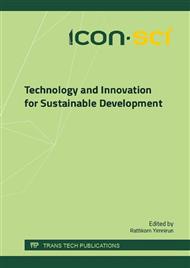p.111
p.115
p.119
p.123
p.127
p.131
p.135
p.141
p.145
Characteristics of Cultivated Sulfur Oxidizing Bacteria Community Isolated from Coal Mine Treatment Plant in H2S Removal
Abstract:
Sulfur cycling based on biological oxidation of sulfide to sulfate involves sulfur-oxidizing reducing microbial communities associated with sulfide which normally oxidize sulfide in acidic environment to sulfate. The chemolithotrophic sulfur oxidizing bacteria (SOB) usually use organic and/ or inorganic sulfide initially oxidizing and subsequently released sulfate under aerobic or subaerobic condition. This study was to understand SOB community isolated from coal mine treating plant at Mae Moh, Lampang and their potentials in hydrogen sulfide (H2S) removal. In this result, with common heterotrophic medium supplemented with glucose 10 mg/ L and sulfur 0.001%, the cultured SOB were successfully cultivated based on most probable number method. Their activity showed an increase in sulfate concentration over time correspondent to an increase in culturable SOB communities. The SOB community could also develop their own microbial niches in the present of continuously aerated H2S in the medium at 30-40°C during 7 day incubation. They could remove H2S between 200-500 ppm from wastewater. These sulfur oxidized H2S contaminated in wastewater treatment facilities or drainage. Their species will be further isolated and characterized by molecular analysis.
Info:
Periodical:
Pages:
127-130
Citation:
Online since:
July 2016
Authors:
Keywords:
Price:
Сopyright:
© 2016 Trans Tech Publications Ltd. All Rights Reserved
Share:
Citation:


